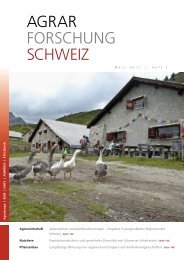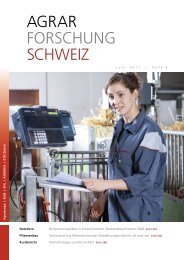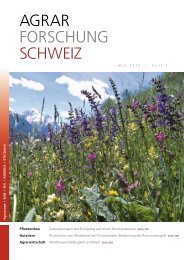Télécharger le PDF - Agrarforschung Schweiz
Télécharger le PDF - Agrarforschung Schweiz
Télécharger le PDF - Agrarforschung Schweiz
You also want an ePaper? Increase the reach of your titles
YUMPU automatically turns print PDFs into web optimized ePapers that Google loves.
Riassunto<br />
Il senecio acquatico germoglia velocemente<br />
e in grande quantità<br />
Da alcuni anni il Senecio aquaticus<br />
(senecio acquatico), tossico per gli<br />
animali da reddito, è in aumento nel<strong>le</strong><br />
superfici inerbite agrico<strong>le</strong>. Per migliorarne<br />
la regolazione, ART ha esaminato<br />
in una serie di esperimenti standard la<br />
germinazione e la durata di vita del<br />
seme di Senecio.<br />
La percentua<strong>le</strong> di germinazione di semi<br />
freschi e maturi di S. aquaticus nel<br />
2008 si situava, in media, al 68 %,<br />
mentre nel 2010 raggiungeva solo il<br />
45 %, indicando così del<strong>le</strong> fluttuazioni<br />
annuali della germinabilità. Dieci giorni<br />
dopo l'inizio dell'esperimento era<br />
germogliato generalmente più del<br />
45 % di tutti i semi; dopo otto settimane,<br />
si osservava solo raramente<br />
un'ulteriore germinazione. I semi,<br />
sotterrati per uno o due anni, mostravano,<br />
con il 78 %, un tasso di germinazione<br />
significativamente superiore<br />
rispetto a semi freschi e maturi, fatto<br />
che implica un effetto di stratificazione<br />
stimolante in condizioni invernali<br />
freddo-umide e una lunga durata di<br />
vita dei semi nel suolo.<br />
Dalla veloce e e<strong>le</strong>vata germinazione del<br />
S. aquaticus si deduce che un'efficace<br />
strategia di regolazione per <strong>le</strong> superfici<br />
inerbite agrico<strong>le</strong> dovrebbe in primo<br />
luogo impedire la produzione e la diffusione<br />
di semi. Se lo S. aquaticus è<br />
presente in grandi popolazioni, la<br />
specie avrà creato un’importante e<br />
durevo<strong>le</strong> banca di semi nel suolo. In<br />
questo caso una regolazione di<br />
successo impiegherà diversi anni finché<br />
la banca di semi nel suolo sarà esaurita.<br />
La germination du séneçon aquatique est rapide et prolifique | Production végéta<strong>le</strong><br />
Summary<br />
Senecio aquaticus shows rapid and<br />
high seed germination<br />
Senecio aquaticus (marsh ragwort),<br />
poisonous to livestock, has become<br />
increasingly abundant in agricultural<br />
grassland. In this study, the germination<br />
and seed survival of S. aquaticus<br />
were investigated in a series of<br />
standardised tests with the aim to<br />
improve the species’ control in managed<br />
grassland.<br />
Germination percentages of fresh ripe<br />
seeds of S. aquaticus were on average<br />
68 % in 2008, but only 45 % in 2010,<br />
indicating yearly variation. In many<br />
cases, over 45 % of all the seeds had<br />
germinated ten days after the start of<br />
testing with almost no germination<br />
occurring after eight weeks. Seeds<br />
buried in the soil for one and two<br />
years had a germination of 78 % –<br />
significantly higher than that of fresh<br />
ripe seeds – suggesting that cold-wet<br />
stratification had a stimulating effect<br />
on germination and indicating longterm<br />
seed survival in the soil.<br />
The rapid and high germination of<br />
S. aquaticus suggests that strategies to<br />
control the species in agricultural<br />
grassland should initially focus on the<br />
prevention of seed production and<br />
dispersal. Once the species is present in<br />
large numbers, it will already have<br />
established a large and permanent soil<br />
seed bank. In such cases, successful<br />
reduction of S. aquaticus may take<br />
several years until the soil seed bank is<br />
dep<strong>le</strong>ted.<br />
Key words: germination percentage,<br />
germination rate, light, soil cover.<br />
Recherche Agronomique Suisse 3 (7–8): 366–373, 2012<br />
373
















